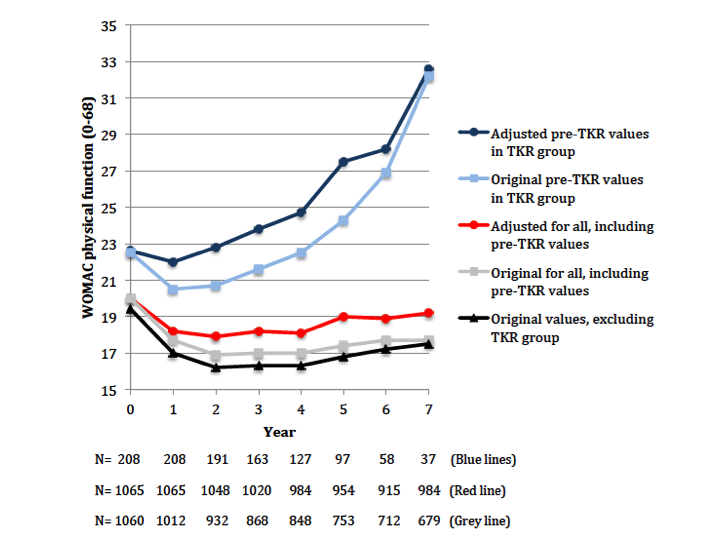Session Information
Session Type: Abstract Submissions (ACR)
Background/Purpose: Longitudinal studies of people with knee osteoarthritis (OA) have reported stable or improved physical function, contrary to the progressive degenerative nature of OA. The early improvement may be from regression to the mean, because subjects enroll when they are in pain. Limitations to current studies are exclusion of subjects with missing data, and of total knee replacements (TKRs). Little is known when including imputation of missing values and pre-TKR physical function data. The aim of this study was to describe physical function over 7 years among subjects with symptomatic knee OA before and after imputation of missing values, and inclusion of pre-TKR physical function values.
Methods: Participants from the Osteoarthritis Initiative (OAI) with symptomatic knee OA at baseline were included, excluding those with hip replacement, those that died, and with TKR at baseline. We defined symptomatic knee OA when at least one knee showed Kellgren and Lawrence grade >1 by x-ray and pain on most days the last month. WOMAC physical function (pf) (0-68) was assessed annually over 7 years in clinic visits. We set the post-TKR values to missing. For all, missing WOMAC-pf values were imputed using the multiple imputation method. For the TKR group, time from the last clinic visit prior to TKR was regressed on WOMAC-pf using a fitted LOESS curve. Then, new predicted WOMAC-pf values were assigned to the existing pre-TKR values, to provide values close to the actual time of the TKR. Mixed effect models were used to compare original WOMAC-pf values against adjusted values (after imputation and prediction of pre-TKR values) (grey vs. red lines in the figure).
Results: Of 4344 eligible people in OAI, 1065 (24.5%) had symptomatic knee OA at baseline (age: 61.3±8.9 years, women: 58.4%, BMI: 30.3±5.0). There were 163 unilateral and 45 bilateral TKRs (19.5%). There was no significant difference in WOMAC-pf between original values and adjusted values, although incorporating data on missing and predicted pre-TKR values left WOMAC-pf worse on average (figure, red and grey lines), and created a larger sample followed over time than original analyses in which pre-TKR and missing values were excluded.
Conclusion: Physical function over time is sensitive to missing values when excluding people who go through TKR and missing clinic visits. Including imputation of missing visit and adjusted pre-TKR values better depicts physical function in persons with symptomatic OA, and permits the evaluation of function in many persons left out of current studies.
Figure. WOMAC physical function over 7 years among people with symptomatic knee osteoarthritis.
Disclosure:
B. E. Øiestad,
None;
D. White,
None;
R. Booton,
None;
J. Niu,
None;
Y. Zhang,
None;
J. C. Torner,
None;
C. E. Lewis,
None;
M. C. Nevitt,
None;
M. P. Lavalley,
None;
D. T. Felson,
None.
« Back to 2014 ACR/ARHP Annual Meeting
ACR Meeting Abstracts - https://acrabstracts.org/abstract/the-natural-course-of-physical-function-in-people-with-symptomatic-knee-osteoarthritis-data-from-the-osteoarthritis-initiative/

